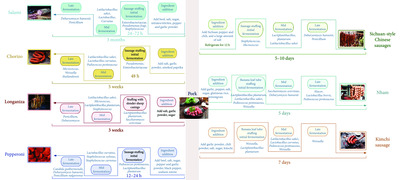How microbes transform flavour in fermented sausage

Fermented sausages are valued not just for preservation but for their rich taste and texture. These qualities arise from complex microbial interactions that break down meat into flavourful compounds.
Microorganisms like lactic acid bacteria (LAB), yeasts and moulds perform metabolic transformations that create the sour, fruity, smoky and savoury notes we associate with regional varieties.
However, the variability in ingredients, fermentation conditions and microbial sources often makes flavour control a challenge. Due to these uncertainties, further investigation into microbial succession and flavour development was done by researchers from Shenyang Agricultural University and Beijing Guomao Dongfu Engineering Technology Co. Ltd.
The new review published in Food Science of Animal Products compares the microbial communities and fermentation strategies in Eastern and Western sausage styles, revealing how microbial succession — from lactic acid bacteria to yeasts and moulds — plays a pivotal role in shaping characteristic flavours and textures. The findings provide a scientific roadmap for modernising traditional techniques while preserving cultural identity.
The review covers the flavour-forming mechanisms of fermented sausages by tracing the progression of microbial communities throughout the fermentation process. Western sausages like salami and chorizo benefit from industrial fermentation, where LAB such as Latilactobacillus sakei and Lactobacillus curvatus initiate acidification and protein breakdown.
These steps lay the foundation for flavour compounds like ethyl acetate and phenylacetic acid that create fruity and floral notes. Later, moulds such as Penicillium and yeasts like Debaryomyces hansenii enrich the profile with smoky, woody and creamy aromas.
In contrast, Eastern varieties like Sichuan-style, Nham and kimchi sausages are shaped by natural fermentation, often involving local microbial flora and culturally specific ingredients like glutinous rice or kimchi. This results in broader microbial diversity and flavour variability, with strains like Lactiplantibacillus plantarum and Weissella producing unique sourness, umami and herbal notes.
The researchers highlight that the succession from LAB to staphylococci, yeasts and moulds is essential to the final taste, texture and safety of these products. Understanding these transitions opens up possibilities for optimising fermentation tailored to both traditional and industrial needs.
“Fermentation isn’t just about preservation — it’s about craftsmanship at the microbial level,” explained Dr Mohan Li, lead author of the study. “By mapping how microbial communities evolve during sausage production, we can better control flavour outcomes and elevate both safety and consistency. This knowledge is especially valuable as traditional techniques meet modern expectations. We’re essentially unlocking nature’s flavour code — one microbe at a time.”
Understanding microbial succession provides a tool for producers. It allows fine-tuning of flavours, standardisation of production and assurance of safety. It may also inspire advances in other fermented foods like cheeses, kimchi and cured meats.
Beany flavour study to enhance the appeal of soy-based foods
A scientific study at the University of Missouri is exploring novel ways to improve the flavour...
FCR image bank provides precise food cue feedback
GMU's Food Cue Reactivity image bank update produces more accurate and consistent...
Aust and NZ baby food nutritional claims unfounded: study
New research has shown that baby foods often feature misleading claims aimed at convincing...












